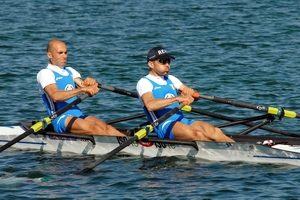 In closing the last post I wrote that an important aspect of warming up for high impact aerobic activity consists in raising the aerobic power, so that as much as possible of the power generated during the activity is delegated to the oxidative mechanisms. Let’s look into this further, as it’s quite important.
In closing the last post I wrote that an important aspect of warming up for high impact aerobic activity consists in raising the aerobic power, so that as much as possible of the power generated during the activity is delegated to the oxidative mechanisms. Let’s look into this further, as it’s quite important.
As we know (eg. from here), to recharge the phosphagen used by the contraction, the muscle uses oxygen to oxidize and completely degrade sugar and fats (glucose and fatty acids) to water and carbon dioxide. We are therefore talking about oxidative or aerobic mechanisms.
The power (ie the energy produced within the time unit) of the aerobic mechanism depends on many factors, including the amount of available oxygen in the muscle fiber. If the power required by the muscle (ie. the speed with the phosphagen is being utilized) is superior to the aerobic power, the rest of the power is obtained by the creation of lactic acid. In other words: the stronger we are, the more lactic acid we produce.
The fact is that aerobic power is a not constant related to our athletic condition, but actually increases according to the work we are doing at the time. When we’re sitting in an armchair, we produce little power through oxidation, when we go for a run in the park we produce a lot. With high impact aerobic activity (which is, by definition, extensive, and lasts at least several minutes), we can even say that the harder the workout, the more aerobic power we produce. The maximum aerobic power is actually reached when we produce a certain amount of lactic acid, when the body is evidently working hard to contain the lactacidemia.
An example: let’s say that I can run at a rate of 5 ‘/ km (corresponding to a speed of 12 km/h) while balancing my oxygen, (i.e without producing lactic acid) and that this is my maximum aerobic pace (if I go faster, I start to produce lactic acid). If this is true, it is also true that if I got up from my usual armchair and suddenly started running at 5 ‘/ km I would certainly produce lactic acid, because my aerobic mechanisms havn’t been stimulated, and my aerobic capacity is low. It begins to increase, however, as I run, fueled by a decline in muscle phosphagen and the presence of lactic acid. As long as the aerobic power does not reach the regime, the power that is lacking will be supplied by lactic acid.
So what happens is, a certain amount of lactic acid is created for every minute of running, but this quantity is less and less as time goes on, because the oxidative mechanism is meanwhile slowly activating itself the best it can.
If we keep a constant speed, we get to a point where lactacidemia no longer increases, it first stabilizes and then actually begins to decrease, as the oxidation power increases. Lactic acid, then, is produced only in the initial transition period.
How to strategically exploit these dynamics?
Given that in a race I will not run at 5 ‘/ km, but much more quickly, and will therefore necessarily produce lactic acid, it is clear that it is in my interests to produce the least amount possible, or to delay the time when I have to stop because I’ve reached my lactacidemia limit.
I must then start the race having already brought the oxidation to a high level of power, so as to avoid the transient lactic acid that we have described, or to generally minimize the lactacidemia total during the competition.
So, when it comes to a specific warm-up for high-impact aerobic activities, the athlete begins to make the technical movements at an initially mild intensity, balancing work and breaks to stimulate the most of the oxidative mechanisms producing the least possible amount of lactic acid. For example, after a general warmup, a cross-country skier will start with a slow run a few minutes long, working up to the point before they lose their breath. Typically this stage lasts from 15′ to 20′. After a short break and some stretching exercises and technique, they then start to run longer or shorter distances (depending on the specialty, from some tens to hundreds of meters) interspersed with rest breaks, at higher and higher speeds to eventually reach (but not exceed) the speed of the race. The choice of rhythms, pauses and quantity depends on the sensitivity of the athlete and his/her experience.
Try it yourself. The perception of one’s aerobic threshold is a feeling that every athlete, at any level, amateur or professional, should develop well.
Of course the same applies to acyclic activities such as sports or fighting games: each athlete will choose the appropriate technical gesture to involve the most muscle groups simultaneously.
[Translated from Italian by Hayley Egan]
Image: Italian double-lightweight Bertini and Gilardoni in action. Courtesy of olimpiadi.blogosfere.it


